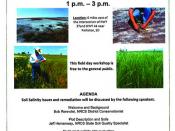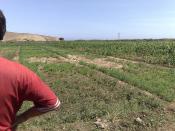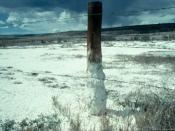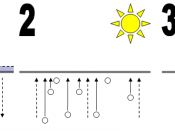Biology: E ffects of S alinity on P lants
"All soils contain water-soluble salts"2. The existence of these salts in the soil, as well as water, is referred to as salinity. Despite the fact these salts are a necessity for plant survival; an excess amount will impair plant growth2. The severity of this impairment is dependent on two variables; the salinity concentration as well as the plant's tolerance towards salt. The soil's salinity concentration is measured by retrieving a sample of water from it then conducting electricity through the water. This results in a measurement known as deciSiemens per metre which can then reveal the amount of salt in solution.
The plant's tolerance towards salt categorizes them into one of four groups. The groups are 'sensitive', 'moderately sensitive', 'moderately tolerant' and 'tolerant'2. For almost all plants, a dS/m below of 1 (.06% concentration of salt in water) is appropriate for optimum growth.
Examples from the 'sensitive' group include apple trees which will die if exposed to soils with a dS/m above 8 (.5%). A plant from the 'moderately tolerant' group however, will only lose a relative growth percentage of 25 if it also was exposed to water with a dS/m of 82. In the year 2001, the total amount of Australian land which had become salinised since European settlement accumulated to 2.5 million hectares5. On a national scale, this may seem insignificant but that is 2.5 million hectares of generally valuable farmland which is now 'useless'5. Also, due to the harsh effects of salinity along with the difficulty in repairing salinised lands, soil salinity can easily define success or failure in crop production for Australian farmers.
Soil salinity has drastic effects on plants. The issue begins when large concentrations of salt (a solute) are present in groundwater. Plants must use far more energy to extract necessary amounts of water (whilst also limiting salt consumption)2. This is due to the nature of osmosis. The groundwater is now a hypertonic solution as it has a higher solute concentrate than the plant's root cells. As a result, plants must expend more energy as osmosis is now occurring against them. This is because the water from the plant's root cells now travels towards the hypertonic solution in an attempt to balance the concentrations. The excess energy used in such instances is diverted away from various necessary processes such as photosynthesis and consequently, growth2. Also, absorbed salts are stored in the leaves periodically but become toxic if there are large amounts6. It is the plant's ability to deal with salt and its concentration that determines the severity of these effects which can range from harmless to fatal. For instance, if the water present for a salt-sensitive plant had an electric current above 8 dS/m (.5%), it would be fatal2. Water with an equal dS/m would be harmless on a plant tolerant to salt2. However, if the tolerant plant's drinking water was above 32 dS/m (2%), it too would also die. This explains why there is generally a lack of plants near seawater as it has a dS/m of approximately 55.
The process which allows plants to absorb required amounts of water is osmosis. It is basically the dispersion of a solvent from a high concentration to a low concentration through a membrane. When groundwater is present in the root zone3 as a hypotonic solution it will disperse through the semi-permeable membranes of the root cells and into the plant. It then reaches the xylem where it is transported throughout the plant. However, when the groundwater is hypertonic (e.g. high salt concentration) the osmotic effect occurs in the soil2.This means the plant must exert more energy to absorb water as it is going against the concentration gradient. This energy is directed away from processes such as photosynthesis, plant movement and transpiration. This is why a lack of growth occurs. Plants produce less energy due to less photosynthesis and absorb less sunlight for photosynthesis as it cannot move itself into an advantageous position. The lower-than-usual amount of energy it then makes must be sent to the roots so minor absorption of water can continue. Growth of other plant parts thus halts as the plant no longer has sufficient amounts of energy to spare.
Soil salinity in Australia is an issue with dire consequences. Its current effects on Australia have resulted in the salinisation of 2.5 million hectares of land. This is only expected to increase to 17 million hectares within 50 years5. That makes up 2.21% of Australian land which can no longer be used for crops and vegetation to support our booming population.
B ibliography
Blaylock, Alan D. (1994). Soil Salinity, Salt Tolerance, and Growth Potential of Horticultural and Landscape Plants. Retrieved April 25, from http://ces.uwyo.edu/PUBS/WY988.PDF
Clark, D. R. & Green, C. J. & Gordon, J. A. (2000). Laboratory Exercises to Demonstrate Effects of Salinity on Plants and Soils. Retrieved April 26, from http://www.jnrlse.org/pdf/2000/e99-10k.pdf
Information for Action. Salinity. Retrieved April 25 from http://www.informaction.org/cgi-bin/gPage.pl?menu=menua.txt&main=salinity_gen.txt&s=Salinity
NOVA: Australian Academy of Science. (2006). Salinity - the awakening monster from the deep. Retrieved April 25, from http://www.science.org.au/nova/075/075key.htm
Slinger, Deborah & Midgley, Tania & Madden, Elizabeth. (2005). How salinity is measured. Retrieved April 25, from http://www.dpi.nsw.gov.au/agriculture/resources/soils/salinity/general/measuring
(1999) Salt: an environmental stress in Plants in Action Atwell.
2 Alan D. Blaylock. (1994). Soil Salinity, Salt Tolerance, and Growth Potential of Horticultural and Landscape Plants. Retrieved April 25, from http://ces.uwyo.edu/PUBS/WY988.PDF
5 NOVA: Australian Academy of Science. (2006). Salinity - the awakening monster from the deep. Retrieved April 25, from http://www.science.org.au/nova/075/075key.htm
2 Alan D. Blaylock. (1994). Soil Salinity, Salt Tolerance, and Growth Potential of Horticultural and Landscape Plants. Retrieved April 25, from http://ces.uwyo.edu/PUBS/WY988.PDF
3 Information for Action. Salinity. Retrieved April 25 from http://www.informaction.org/cgi-bin/gPage.pl?menu=menua.txt&main=salinity_gen.txt&s=Salinity
6 (1999) Salt: an environmental stress in Plants in Action Atwell
5 NOVA: Australian Academy of Science. (2006). Salinity - the awakening monster from the deep. Retrieved April 25, from http://www.science.org.au/nova/075/075key.htm





